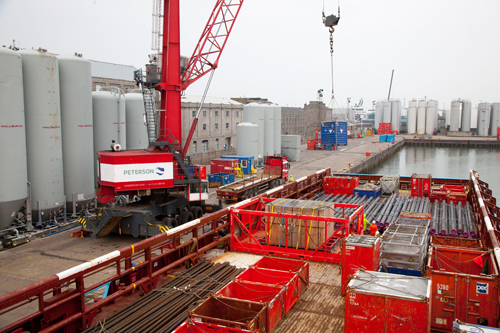 Platts – U.S. oil prices would have to fall another 20% or so before one of the leading American shale oil producers, Continental Resources, would cut back significantly on its operations, the company's CEO said Sunday on Platts Energy Week.
Platts – U.S. oil prices would have to fall another 20% or so before one of the leading American shale oil producers, Continental Resources, would cut back significantly on its operations, the company's CEO said Sunday on Platts Energy Week.
"We're hurt, but we're not to the point we're shutting down," Harold Hamm said. "And we're not getting close to that, yet, within a pretty good measurable amount, you know, $15 or $20. And certainly that's the case in the Bakken."
West Texas Intermediate (WTI) crude oil for December delivery fell 90 cents last week, to close at $81.01 per barrel (/b) Friday.
Hamm, whose company is the second-largest producer in the Bakken, said he was optimistic that the oil price decline would reverse soon.
"I've thought that we ought to be in the $90 range for sure," he said. "And I think the price will quickly come back to that."
Rising demand in China, primarily for transportation, would remain a key driver of world oil prices, he added.
Hamm said he preferred not to talk about the point at which oil prices would cause sharp declines in U.S. drilling activity.
"I don't like to go there, talking about where would you stop," he said. "That gets to be putting more fear into the market, if you will, and panic. And that's certainly not anything we should be talking about."
Nevertheless, such speculation has been prevalent among analysts following the oil price decline. For example, Standard & Poor's Rating Services last week said a reduction in U.S. shale drilling is likely if WTI prices fall below $80/b. S&P, like Platts, is part of McGraw Hill Financial.
Still, Hamm acknowledged that Continental Resources and other companies have begun to scale back some activities in response to the price decline.
"Certainly, we've had a serious reduction in price, losing some $20/b over these last few weeks," he said. "So, that's a pretty good pull-back. And certainly, people will probably start adjusting right there on projects that they can push back or don't have to do for a while. And our company has done the same thing, and others have."
But Hamm said the impacts vary depending on the locations of the wells, the financial needs of individual companies and other factors. The Bakken shale, he added, "probably lends itself to lower prices" more than other shale reserves.
Other Program Highlights
Also Sunday, Brigham McCown, a former head of the U.S. Pipeline and Hazardous Materials Safety Administration, shared some of the infrastructure challenges facing the U.S. oil and natural gas sector.
During another segment, Murray Energy CEO Robert Murray discussed his efforts to help Republicans re-take the U.S. Senate this November amid sentiment that the Obama administration and Democrats in Congress are contributing to the decline of coal.
In "Market Spotlight," Andrew Moore, managing editor of Platts Coal Trader, gave an overview of the myriad factors shaping the U.S. coal market.
Platts Energy Week airs at 8 a.m. U.S. Eastern time Sunday mornings on WU.S.A9 in greater Washington, D.C., and in Houston on KUHT, a PBS affiliate, as well as on other PBS stations in cities throughout the U.S., including Anchorage, Billings, Houston, Juneau, Las Vegas, Minneapolis, San Francisco, Raleigh and Wichita. For online viewing, the program is accessible at www.plattstv.com.


 We all need to remember, but often choose to forget, that oil is a highly cyclical sector. There have been seven significant price cycles since 1970 and also a few minor ones between times, so yet another should come as no surprise. The reasons for the fall in Brent crude prices from $115.19 in June to below $85 last week are well documented, as is the realization that OPEC is now defending market share, rather than a minimum price. That said, the nature of the oil business is very different now compared to after the 2008 crash.
We all need to remember, but often choose to forget, that oil is a highly cyclical sector. There have been seven significant price cycles since 1970 and also a few minor ones between times, so yet another should come as no surprise. The reasons for the fall in Brent crude prices from $115.19 in June to below $85 last week are well documented, as is the realization that OPEC is now defending market share, rather than a minimum price. That said, the nature of the oil business is very different now compared to after the 2008 crash. NYC-based
NYC-based  Since the first successful oil well was drilled by Shell-BP in 1956 at Oloibiri, Nigeria has acclaimed the status of Africa's largest oil producer and the sixth largest in the world. However, the Nigerian oil and gas industry has been engulfed in challenges with few success stories. The statistics are damning: the country loses approximately 215,000bpd to oil theft, at an estimated value of $8 billion a year.
Since the first successful oil well was drilled by Shell-BP in 1956 at Oloibiri, Nigeria has acclaimed the status of Africa's largest oil producer and the sixth largest in the world. However, the Nigerian oil and gas industry has been engulfed in challenges with few success stories. The statistics are damning: the country loses approximately 215,000bpd to oil theft, at an estimated value of $8 billion a year.
 December 2013.
December 2013. Platts
Platts  States and International Oil Companies (IOCs) are banking on the Arctic as a major source of future oil and gas production, but the high costs and risks involved with operations in the area mean that an attractive fiscal regime is essential if developments are to be commercially viable, says an analyst with research and consulting firm
States and International Oil Companies (IOCs) are banking on the Arctic as a major source of future oil and gas production, but the high costs and risks involved with operations in the area mean that an attractive fiscal regime is essential if developments are to be commercially viable, says an analyst with research and consulting firm